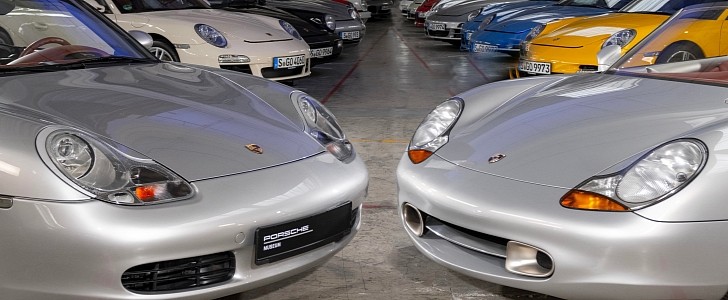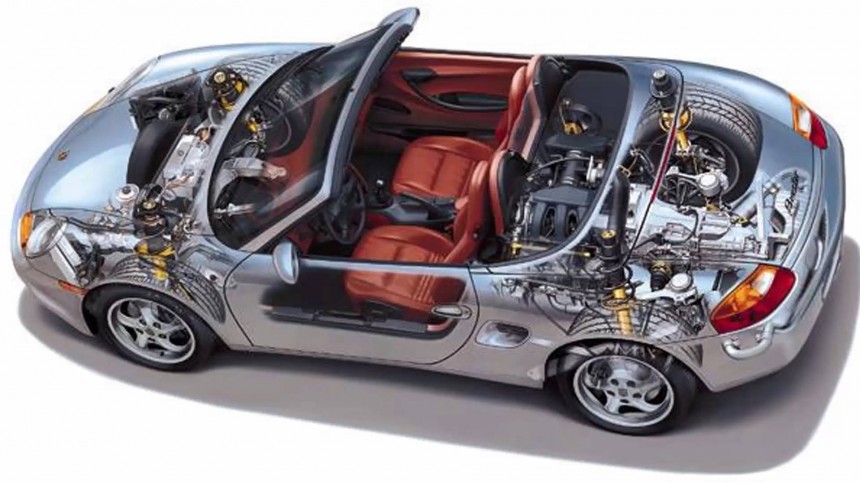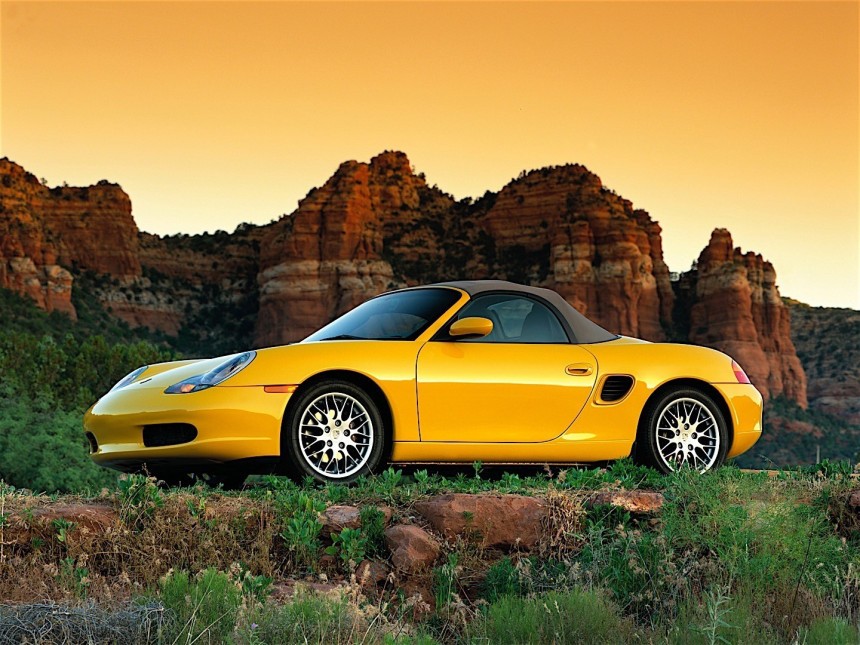Some loved it, some hated it, but the carmaker could name it Porsche Saviour instead of Boxster since it is the car that helped the German sports car brand from bankruptcy in a time when most carmakers faced financial problems, and there was hardly anyone rich enough to save it.
Porsche tried since the mid-'70s to expand its lineup above the 911 model. First, it tried with the 914, together with Volkswagen and the result was terrible. Then, it came with the idea of a more affordable sports car and created the 924. This was a front-engine with rear-wheel drive coupe, which shared no parts with the 911. It evolved later in the 944, then the 928, and concluded with the 968. But in the long-term, it was not a good recipe.
At the beginning of the '90s, Porsche was running out of cash since its sales dropped dangerously from over 50,000 units in 1986 to 14,000 in 1993. The U.S. market also faced a financial problem with only around 3,000 units sold. Porsche was on the verge of bankruptcy. So it came with a new idea, and we followed it in the Concept to Reality story.
Like other carmakers, Porsche tried to link a new model with its existing lineup. While other brands had more models to share parts, it only had one. When Chrysler made the Viper, it had enough resources to develop it. Also, Ford had a large parts bin to share some with the fourth generation of the Mustang. But Porsche had only one option: the rear-engined 911.
Sharing components between models is convenient for a carmaker since it lowers the costs for R&D. It also reduces the production price for those parts. However, since the 968 and 911 didn't share anything significant, the carmaker decided on another approach.
The company's management knew so, in the early '90s, they appointed a new team to develop a more affordable open-top car. Inspired by the success of the Mazda MX5/Miata, Porsche decided to follow that recipe, but with its own twist. It took back the famous 550 Roadster from its museum and tried to make a modern version of it. The new model had to be a mid-engine sports car. Interestingly, the road from concept to reality only took three years, but it was not without hiccups, being frozen for a few months.
Grant Larson was responsible for designing the car and started to work on it in 1991. First, he made it in an old-school way, on paper. Then Peter Muller stepped in. Based on Larson's drawings, he created a 3D model in clay, and he did a fantastic job. Harm Lagaay was the new head of the Style Porsche department after returning from BMW, where he did the Z1. Before that, the Dutchman penned the 924, who saved Porsche during the oil crisis in the early '80s. His vision was right then, so he worked his miracle again.
Lagaay pushed the R&D department to finish the work before the 1993 Geneva Motor Show. Yet, the team burned the midnight oil and made it sooner than anyone expected, and it was unveiled at the 1993 North American International Motor Show (NAIAS) in Detroit. It was a surprising presence that bore the name Boxster, a combination between "boxer" and "roadster."
It was the last shot Porsche could afford, and it bet all its money on it. The public's reaction exceeded the carmaker's expectations. Even though some detractors said that "it's the poor man's 911," that didn't stop the Germans from building it. But it took no shortcuts. It didn't want to hear about anything else than a flat-engine and a five-speed manual as standard features.
Moreover, since the U.S. market was dominated by automatic transmissions, Porsche offered it with a Tiptronic gearbox, which allowed the driver to sequentially change the gears via buttons on the steering wheel, combining the pleasure of a three-pedal car with the comfort of an automatic.
Less than three years after it unveiled the concept car, Porsche released the production model of the Boxster, codename 986, at the 1995 Paris Motor Show. To speed up the manufacturing process, Porsche hired former engineers from Toyota to help it plan the assembly line.
Unlike the concept car, the series version featured an elongated front side, identical to the future (then) Porsche 911 – 996. The roadster featured a 2.5-liter water-cooled flat-six engine that developed 204 hp paired to a standard five-speed manual. Its power-retractable cloth roof and the sporty styling were some of the reasons why it became an instant attraction.
The production model sported higher-mounted side air intakes than the concept car. Thus, the engine could get cleaner air into the cylinders. Being a mid-ship vehicle, its mass distribution was better, the driver had a better driving position with a clear view ahead. Porsche kept its promise and delivered a more affordable sports car with the same driving spirit.
The result was not a poor man's 911. Instead, it was a different kind of roadster. One that could genuinely evoke the spirit of the 550 Spyder in a way that the 914 couldn't, and the 911 never intended. That's why the Boxster was a success, and later on, it evolved into the Cayman and in the 917.
At the beginning of the '90s, Porsche was running out of cash since its sales dropped dangerously from over 50,000 units in 1986 to 14,000 in 1993. The U.S. market also faced a financial problem with only around 3,000 units sold. Porsche was on the verge of bankruptcy. So it came with a new idea, and we followed it in the Concept to Reality story.
Like other carmakers, Porsche tried to link a new model with its existing lineup. While other brands had more models to share parts, it only had one. When Chrysler made the Viper, it had enough resources to develop it. Also, Ford had a large parts bin to share some with the fourth generation of the Mustang. But Porsche had only one option: the rear-engined 911.
Sharing components between models is convenient for a carmaker since it lowers the costs for R&D. It also reduces the production price for those parts. However, since the 968 and 911 didn't share anything significant, the carmaker decided on another approach.
Grant Larson was responsible for designing the car and started to work on it in 1991. First, he made it in an old-school way, on paper. Then Peter Muller stepped in. Based on Larson's drawings, he created a 3D model in clay, and he did a fantastic job. Harm Lagaay was the new head of the Style Porsche department after returning from BMW, where he did the Z1. Before that, the Dutchman penned the 924, who saved Porsche during the oil crisis in the early '80s. His vision was right then, so he worked his miracle again.
Lagaay pushed the R&D department to finish the work before the 1993 Geneva Motor Show. Yet, the team burned the midnight oil and made it sooner than anyone expected, and it was unveiled at the 1993 North American International Motor Show (NAIAS) in Detroit. It was a surprising presence that bore the name Boxster, a combination between "boxer" and "roadster."
It was the last shot Porsche could afford, and it bet all its money on it. The public's reaction exceeded the carmaker's expectations. Even though some detractors said that "it's the poor man's 911," that didn't stop the Germans from building it. But it took no shortcuts. It didn't want to hear about anything else than a flat-engine and a five-speed manual as standard features.
Less than three years after it unveiled the concept car, Porsche released the production model of the Boxster, codename 986, at the 1995 Paris Motor Show. To speed up the manufacturing process, Porsche hired former engineers from Toyota to help it plan the assembly line.
Unlike the concept car, the series version featured an elongated front side, identical to the future (then) Porsche 911 – 996. The roadster featured a 2.5-liter water-cooled flat-six engine that developed 204 hp paired to a standard five-speed manual. Its power-retractable cloth roof and the sporty styling were some of the reasons why it became an instant attraction.
The production model sported higher-mounted side air intakes than the concept car. Thus, the engine could get cleaner air into the cylinders. Being a mid-ship vehicle, its mass distribution was better, the driver had a better driving position with a clear view ahead. Porsche kept its promise and delivered a more affordable sports car with the same driving spirit.












